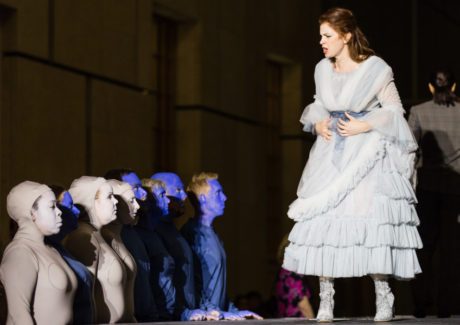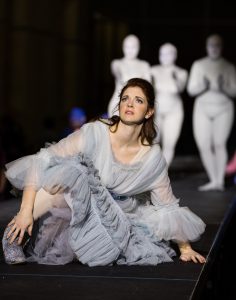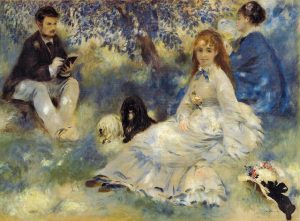
The Wake World. Music and libretto by David Hertzberg. Opera Philadelphia at the Barnes Foundation, September 2017.
Inside a museum dedicated to art from the past, the Philadelphia O17 Festival has brought a new opera which celebrates musical and literary styles from the past. The youthful composer/librettist David Hertzberg built upon musical forms from the same time period, a century ago, when Albert Barnes was acquiring his unique art collection.
This is a clever, site-specific staging that coordinates Opera Philadelphia with the Barnes Foundation. The Wake World takes inspiration from Barnes’s collection of paintings and from a 1907 story written by Aleister Crowley, a British poet, painter and experimenter with recreational drugs. Crowley was profiled in 1915 in Vanity Fair magazine as having “experimented with strange poisons in order to discover the Elixir of Life and the Elixir of Vision.” Hemingway described Crowley in A Movable Feast and the Beatles put him on the cover of Sergeant Pepper’s Lonely Hearts Club Band.
There’s no record of any correspondence between Crowley and Barnes, but both men were provocateurs who derided Establishment values. In his story, Crowley based the central character of Lola on Renoir’s painting of The Henriot Family which hangs in the Barnes gallery. Crowley’s and Hertzberg’s Lola wanders about a wonderland, exploring palaces and temples, like an observer moving through Barnes’s museum. Hertzberg says about the Barnes collection: “It feels like a crazy temple, definitely mysterious, and just so strange.”
Hertzberg’s music starts in an impressionist mode reminiscent of Debussy, with the use of whole tone, pentatonic and octatonic scales. It expands to a palette like Ravel’s Daphnis et Chloe, with enlarged volume range and a mixed chorus.
Then comes a transition to music that sounds like the Russian mystic Alexander Scriabin (1872-1915) who wrote compositions that build to great climaxes while the tonal center is nebulous and elusive. Not only did Hertzberg’s music pay homage to Scriabin, he also clearly was inspired by the Russian’s linking of sounds with colors. Scriabin associated specific tones with certain hues; he believed that D major was golden-brown and E-flat major was red-purple, for example. His Prometheus: The Poem of Fire included a part for a machine that projected the colors Scriabin associated with each key. (Leopold Stokowski led its American premiere with the Philadelphia Orchestra.)
This, therefore, is a wonderful linking of sound, visuals, and site. Hertzberg does not merely copy Scriabin; he bolsters the style using diaphanous, hypnotic repetitions and spread-out textures. Segments follow one another in non-developmental order, floating and dissolving in a continuous, unbroken flow that explores sensuous sound colors.
This is labeled as a “chamber opera” presumably because the audience seating space is small. Yet the sound of the orchestra is rich and full bodied, and abetted by a sizeable chorus. Hertzberg’s instruments include a string quartet and also a dazzling array of percussion instruments — vibraphone (with aluminum bars and resonator tubes), glockenspiel (like a xylophone but with metal bars), melodica (a tiny keyboard that sounds like a harmonica), tom toms (cylindrical drums), tam tam (flat-faced gong of indefinite pitch), crotales (antique cymbals consisting of small bronze or brass disks), bass drum, musical saw, wind gong, ratchet, chimes, suspended cymbal, sizzle cymbal, and thunder sheet.
The cast is headed by soprano Maeve Höglund as Lola and mezzo Rihab Chaieb as her Fairy Prince. I was impressed with Höglund when she sang the female lead in Carlisle Floyd’s opera Prince of Players in New York last season, and now she emerges as a superstar who encompasses brilliant high notes and chesty low ones with strong dramatic flair and believable acting.
Director R.B. Schlather situates his performers in the long Annenberg Court just outside the Barnes exhibit rooms, on and alongside a catwalk. Sometimes the singers fan out among the audience and, near the end, they leave the room to walk in the Barnes outdoor garden before returning for a final ensemble indoors.
Conductor Elizabeth Braden deserves immense credit for coordinating all musical elements in this elongated performing space where individual choristers in separate corners of the hall have to harmonize precisely with other singers who are far away from them. The costumes by Terese Wadden are in a strange assortment of colors and many of the players have facial makeup (by David Zimmerman) that matches their costumes. Aside from Lola’s, they do not relate to any specific Barnes paintings.
When you try to relate to the flowery lyrics, just keep in mind Crowley’s unique personality. Tying the music and artwork together are visually-specific lyrics such as “The vermillion frothing, cinnabar seething in my veins; Carved of pale olive-colored marble awash in lemon-colored soot; Drink deep of the purple ambergris, lift your crescent lids and breathe the silver radiance of the moon; Glow-orange scarlet, amber scarlet-flecked gold, quicksilver storax, fire opal-flecked sol; flaxen-flecked fire, cadmium crimson-speckled gold, all made of malachite and emerald, carved in silken crysolith.”
So this is an immersive experience which transports the audience into an other-worldly existence. “Is this dream or are we awake?” asks Lola. The Wake World has us asking ourselves the same question.
Below, Höglund on stage, and the Renoir painting on which the opera is based:

